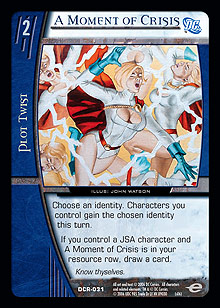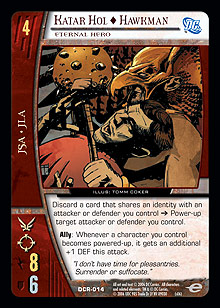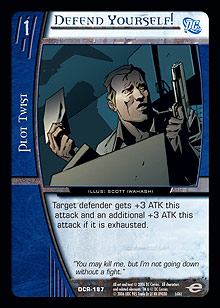With the Infinite Crisis Draft season slowing down and the local scene tiring of my endless pestering for drafts, I thought I would finish off this format with more of an in-depth look at the teams of this set. Cards can never be evaluated in a vacuum; they always need context. Over at StarCityVs.com, I have been posting a card-by-card review of this set, and I think that reading that would complement this column nicely. However, this format seems to be much less about building a deck as an accumulation of good cards and more about exploiting the various subtle and not so subtle combinations that lie scattered within it. Drafting archetypes has always been an important part of the arsenal of a good Sealed Pack player, but now more than ever, a deck that seeks to be more than just the sum of its parts is needed to win in Vs. Booster Draft. This article will take a look at the synergies available to the JSA, and we will continue next week with a look at another team.
Identity
One of the themes of the JSA is identity. For the uninitiated, the identity of a character is the word(s) located immediately after a à symbol next to that character’s name on the top line of text. The line below this is the version. Before this set, identity was almost irrelevant. With Infinite Crisis and the JSA, identity was brought into the spotlight.
There are a several cards that reference identity in Infinite Crisis Draft. There are the sets of characters that share an identity: the Hawkmen, the Hawkwomen, the Hourmen, and the Mr. Terrifics (and Mordru, Dark Lord, in addition to them). Characters with the same identity can be played alongside each other without falling prey to uniqueness. To complement the identity theme of these characters, there are several plot twists that reference identity. These are A Moment of Crisis, Double Play, Heroic Rescue, Living Legacy, and Taking Up the Mantle (and Fate Has Spoken, though it is not really relevant to the JSA). So, is there anything to be gained from drafting a deck based around characters of the same identity?
Something that needs to be recognized straightaway is that, on its own, identity does next to nothing in terms of game function. Having cards that share an identity does not in and of itself provide any advantage. Without cards that can convert your character cards in hand into effects, identity is meaningless.
Only two of the characters mentioned have abilities that reference identity. They are Kendra Saunders à Hawkgirl, Eternal Heroine and Katar Hol à Hawkman, Eternal Hero. Both of these characters allow you to power-up characters in play with character cards from hand that share an identity. On top of that, they offer you bonuses that extend beyond the normal powering-up bonus.
 The plot twists are generally support cards. A Moment of Crisis allows you to give a character a specific identity, which, as shown above, does little by itself. Taking Up the Mantle is a narrower way of doing this with a slight bonus. Double Play and Heroic Rescue are effects that are based on identity but are not really that powerful. Legacy is decent, but it is good only once you have certain characters of different identities at different places on the curve; it does little before then.
The plot twists are generally support cards. A Moment of Crisis allows you to give a character a specific identity, which, as shown above, does little by itself. Taking Up the Mantle is a narrower way of doing this with a slight bonus. Double Play and Heroic Rescue are effects that are based on identity but are not really that powerful. Legacy is decent, but it is good only once you have certain characters of different identities at different places on the curve; it does little before then.
To take advantage of this theme, we have to place a high priority on the characters that allow us to utilize character cards with shared identities, because until we have an outlet for the plot twists, they won’t be much use on their own. Kendra offers us +1 ATK to each power-up we perform within the identity theme. Katar offers us +1 DEF for the same function. Both have the potential to be very powerful, assuming we have access to several identity power-ups. But one is definitely better than the other, at least in the sense that we are trying to build an archetype.
When you are playing an on-curve deck, which most Draft decks typically are, your ultimate goal is to brickwall someone. Brickwalling is when you force an opposing attack to fail by creating a character that cannot be stunned by your opponent’s attacker(s). This is usually done through DEF enhancement. The potential to brickwall is so devastating that any cards or combinations of cards that can offer you a realistic chance to do so regularly should not be overlooked. Katar Hol à Hawkman, Eternal Hero gives you that chance.
 At first glance, an 8 ATK / 6 DEF character doesn’t look built for defending. Yet with one power-up, Katar will become 9 ATK / 8 DEF, which is nothing to sneeze at for a 4-drop and already forces any 7 ATK character to pump for a stun. With two power-ups, Katar becomes an absolute monster at 10 ATK / 10 DEF, requiring a massive effort by any 4-cost character or below to ensure a stun. So, how realistic is getting multiple power-ups regularly? For starters, there are three common Hawkmen: Prince Khufu à Hawkman, Eternal Warrior; Katar Hol à Hawkman, Eternal Hero; and Carter Hall à Hawkman, Eternal Champion. A Moment of Crisis and Living Legacy can help you turn on Katar’s text, as well. On top of this, Mordru, Dark Lord and Return of Donna Troy can add redundancy to your plan of powering-up through identity and gaining Katar’s bonus. Not only does there seem to be enough gas to ensure that if you can pick up a Katar, he will have support, but there also seems to be enough of a possibility with cards that create identities other than Hawkman to add DEF at other points on the curve.
At first glance, an 8 ATK / 6 DEF character doesn’t look built for defending. Yet with one power-up, Katar will become 9 ATK / 8 DEF, which is nothing to sneeze at for a 4-drop and already forces any 7 ATK character to pump for a stun. With two power-ups, Katar becomes an absolute monster at 10 ATK / 10 DEF, requiring a massive effort by any 4-cost character or below to ensure a stun. So, how realistic is getting multiple power-ups regularly? For starters, there are three common Hawkmen: Prince Khufu à Hawkman, Eternal Warrior; Katar Hol à Hawkman, Eternal Hero; and Carter Hall à Hawkman, Eternal Champion. A Moment of Crisis and Living Legacy can help you turn on Katar’s text, as well. On top of this, Mordru, Dark Lord and Return of Donna Troy can add redundancy to your plan of powering-up through identity and gaining Katar’s bonus. Not only does there seem to be enough gas to ensure that if you can pick up a Katar, he will have support, but there also seems to be enough of a possibility with cards that create identities other than Hawkman to add DEF at other points on the curve.
Clearly, Kendra is great in this type of deck, and even cards like Superman, Earth 2 and Barbara Gordon à Oracle, Data Broker can be excellent complements to the overall plan. On top of those, The Phantom Stranger, Wandering Hero can be awesome. Make no mistake, though—this is a deck based around Katar, and he is your main priority. ATK bonuses are great, but DEF bonuses are better (particularly when powering-up boosts your ATK anyway), and an attacking 3-drop is much harder to keep on the board than a defending 4-drop. Due to the weakness of the plot twists in any other deck, you can afford to try to wheel important cards like A Moment of Crisis, Living Legacy, and Return of Donna Troy, focusing instead on picking up the important characters (like Mordru and Prince Khufu once you have Katar Hol). I don’t recommend forcing this deck until you pick up Katar himself, but you can always snag some Moments and Legacies on the wheel of the first and second packs if you are already in the JSA. You won’t see Katar Hol passed beyond fourth pick very often, but sometimes it might be just as good to deprive someone else of this powerful archetype.
Earth 2
Another theme of the JSA is that several of their characters share the version Earth 2. With Lois Lane, Earth 2; Brainiac, Earth 2; Huntress, Earth 2; Batman, Earth 2; Wonder Woman, Earth 2; Power Girl, Earth 2; and Superman, Earth 2, there is in effect a character for every drop (with a 6-drop boosting on turn 7 or 8). Each of the characters has some sort of text or ability that references characters or character cards referencing Earth 2, so there is a lot of overlap and potential synergy between the characters.
From the outset, we need to note that we cannot realistically hope to recruit an Earth 2 character each turn, as there are so few of them and no way to team them up (apart from Huntress, but I will get to that in a second). To that end, what we are looking for are two-card combinations—incidental advantages rather than a deck built around the advantage offered by a single card (such as the identity deck above). It helps enormously that all of the Earth 2 characters apart from Lois are playable on their own, and some (like Power Girl) are naturally high picks already . . . though that can also be a downside because we cannot expect to see these cards all the time. The potential scarcity reinforces the need to focus on two-card combinations.
So, which Earth 2 cards lend themselves most easily to combinations with other cards? Well, given that each Earth 2 character has an ability dependent on having other Earth 2 characters, Huntress is definitely the most flexible character for the team. Acting as the only effective team-up for the team can turn Lois into a powerhouse search card, make Brainiac into a mini-Bastion of sorts, or even allow you to exhaust characters at will with Batman. Huntress is a 5 ATK / 4 DEF character on her own, so she’s no slouch, and it seems like the longer she is able to stay on the board, the more avenues of abuse become available. Picking Huntress early will allow you to value the other Earth 2 characters more highly as the draft progresses.
I mentioned the combination with Brainiac above, and I am happy to go on record with the claim that Brainiac is probably the most underrated card in Infinite Crisis Booster Draft. Not only do you get a fantastic ability that is made game-winning by Huntress or any generic Team-Up (of which there are plenty in this set), but you also get a character that is protected by its concealed status and able to boost on turn 3 in a pinch. Brainiac regularly wheels at tables I have observed, and I am sure this means that at least six people are making errors. This format is much more defensively motivated than past formats, and having a guy on your team who doesn’t require much effort to generate -2 ATK / -2 DEF will win you more games than you might think. If anything, Huntress turning on Brainiac is the most powerful Earth 2 combination, though he can be almost as good when your other teams are teamed-up with Anti-Matter.
All of the Earth 2 characters are solid, but it seems that Huntress and Brainiac are the best picks. This is because they are fine on their own and also provide you with the realistic potential to bring your other Earth 2 cards into play. You can generally be happy picking up any of the Earth 2 characters, though to begin to think of them as Earth 2 and not just as good JSA requires that you have Huntress or Brainiac. Drafting a deck with Earth 2 synergies tends to be more about having a solid and straightforward deck with options for shenanigans, rather than the almost-combo deck that the identity theme inspires. There is a little less of a chance for downright brokenness with Earth 2, but overall, you get a much more consistent deck that will randomly just win by itself.
Off-Curve JSA
 I have long been an advocate of off-curve decks, but I have found that in Infinite Crisis Booster Draft, the regular rules of building and playing off-curve don’t seem to apply so well. There is significant potential for building a strong defense in Infinite Crisis, not just from DEF modifiers like Defend Yourself!, Deflection, and various equipment, but also from recovery effects like Revitalize and It’s Not Over Yet and the plethora of concealed or concealed—optional characters that make the typical bonuses for attacking up the curve minimal. All of this has added up to make this set very difficult to exploit in terms of finding a viable off-curve strategy.
I have long been an advocate of off-curve decks, but I have found that in Infinite Crisis Booster Draft, the regular rules of building and playing off-curve don’t seem to apply so well. There is significant potential for building a strong defense in Infinite Crisis, not just from DEF modifiers like Defend Yourself!, Deflection, and various equipment, but also from recovery effects like Revitalize and It’s Not Over Yet and the plethora of concealed or concealed—optional characters that make the typical bonuses for attacking up the curve minimal. All of this has added up to make this set very difficult to exploit in terms of finding a viable off-curve strategy.
The JSA and Checkmate have the best off-curve plans in this format. For the JSA, their off-curve options are fixed on the Mr. Terrifics: Terry Sloane à Mr. Terrific, Golden Age Gold Medalist and Michael Holt à Mr. Terrific, Renaissance Man. When combined with the otherwise solid smaller characters the JSA can muster, there is potential to run riot in the right conditions. Atom Smasher, Al Rothstein; Kate Spencer à Manhunter, Fearless Renegade; and T-Spheres are all good cards in their own right, but they are almost as likely to be snapped up by on-curve decks.
If you want to play an off-curve deck based around the JSA, I don’t think you can do so without at least two copies of the Mr. Terrifics. The odds are stacked against you already, so you need some measure of consistency to your plan or you will just fall apart too easily. Even then, you need to ensure that the conditions for your combat modifiers are met. You will need a card like Relentless Pursuit to bring some redundancy to Kate Spencer, as concealed characters not only negate the ATK bonuses you need to deal enough endurance loss to win games, but they also allow defending players to maintain their board as you attack up and across the curve. You will need to be careful to play around cards like Revitalize, and always be aware of the various defensive tricks of which the Villains United and Shadowpact teams are capable. Overall, I think you need to make much riskier attacks in this format, as the potential for brickwalling is much higher in this set, so you need to press every advantage you get.
All in all, I think the JSA is a fine team to draft, though you need to keep at least one eye on some of the above synergies to win your pod. The raw power of the team can’t really match the vengeance mechanic of Villains United or even a fitted out Shadowpact deck. In your favor, some of the generic plot twists do complement your exhaustion theme, though overall you need to be doing something extra to match the best decks at your table. Fortunately, there is rarely a mediocre character on the JSA roster, so you can be sure that as long as you have a few minor combinations, your deck will have good winning chances. Although there are other strong cards in the team that I didn’t touch on, such as Jay Garrick à The Flash, Golden Age Speedster and the Hourmen, these cards tend to be obviously powerful in their application. Decent characters are a dime a dozen in the JSA, so make sure you know which ones can be just that little bit better.